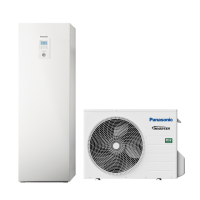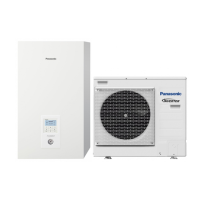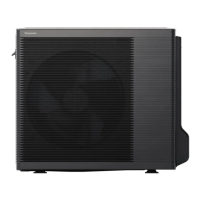Do you have a question about the Panasonic U-4..6ML5XPQ and is the answer not in the manual?
Details essential safety precautions for repair, general operation, and post-repair checks.
Highlights critical safety warnings and precautions to be observed during repair work to prevent injury.
Outlines specific safety considerations and warnings to be followed after the repair work is completed.
Lists essential checks to perform after repair work to ensure the system operates safely and correctly.
Explains the meaning of various icons used throughout the manual to convey specific information.
Provides a detailed list and explanation of all icons used in the manual.
Introduces the service manual and its purpose for the Panasonic Year 2008 UM ML5 series.
Lists all available indoor and outdoor unit models with their specifications and series.
Provides visual representations and names for various indoor unit types.
Details the capacity range and index for outdoor and indoor units, including connection compatibility.
Comprehensive technical specifications for U-4, 5, 6ML5XPQ and U-4, 5, 6ML5DPQ outdoor units.
Detailed technical specifications for various indoor unit types like Ceiling Mounted Cassette, Slim Duct, etc.
Lists all electrical and functional components for outdoor units (U-4, 5, 6ML5XPQ/DPQ) with symbols and remarks.
Lists electrical and functional parts for various indoor unit models, including motors, thermistors, and remote controllers.
Details the refrigerant circuit for outdoor units (U-4, 5, 6ML5XPQ), explaining the function of each component.
Provides a birds-eye view illustration of the outdoor unit with labels for functional parts and their locations.
Illustrates the operational flow of the system, including startup, normal, and special modes.
Explains the basic control mechanisms for compressor and fans during cooling and heating operations.
Describes special control functions like startup, oil return, defrosting, and pump-down operations.
Details various protection controls such as high pressure, low pressure, and inverter protections.
Covers demand operation and heating operation prohibition based on outdoor temperature.
Explains the control logic for indoor units, including drain pump, louver, thermostat, freeze prevention, and swing flaps.
Outlines the step-by-step procedure for conducting the initial test operation after installation.
Explains the unit's behavior and settings when power is first turned on or after unit/PC board changes.
Details how to perform field settings using wired, wireless, and simplified remote controllers.
Explains how to perform field settings using dip switches and PC board settings on the outdoor unit.
Lists common system symptoms, their supposed causes, and countermeasures for troubleshooting.
Guides on troubleshooting using remote controller functions like inspection, test modes, and self-diagnosis.
Lists and explains troubleshooting for indoor unit error codes from A0 to AJ.
Lists and explains troubleshooting for outdoor unit error codes from E1 to J9.
Lists and explains troubleshooting for system, transmission, and power supply related error codes (U0-UH).
Details troubleshooting steps for malfunctions related to centralized and optional controllers.
Provides detailed piping diagrams for outdoor and indoor units, illustrating refrigerant flow and component connections.
Illustrates the electrical wiring connections for outdoor units, indoor units, and field wiring.
Lists available optional accessories and controller settings compatible with various indoor and outdoor units.
Provides tables detailing the resistance values of various thermistors at different temperatures for troubleshooting.
Displays charts showing the relationship between detected pressure and output voltage for high and low-pressure sensors.
Guides on checking and replacing power semiconductors on the inverter PC board using a multimeter.
Discusses the characteristics, pressure, and composition of R-410A refrigerant compared to older types.
Provides guidelines on handling R-410A refrigerant cylinders, including laws, vessel handling, and storage.
Lists essential tools and their compatibility for working with R-410A refrigerant, including gauge manifolds and flaring tools.
Details essential safety precautions for repair, general operation, and post-repair checks.
Highlights critical safety warnings and precautions to be observed during repair work to prevent injury.
Outlines specific safety considerations and warnings to be followed after the repair work is completed.
Lists essential checks to perform after repair work to ensure the system operates safely and correctly.
Explains the meaning of various icons used throughout the manual to convey specific information.
Provides a detailed list and explanation of all icons used in the manual.
Introduces the service manual and its purpose for the Panasonic Year 2008 UM ML5 series.
Lists all available indoor and outdoor unit models with their specifications and series.
Provides visual representations and names for various indoor unit types.
Details the capacity range and index for outdoor and indoor units, including connection compatibility.
Comprehensive technical specifications for U-4, 5, 6ML5XPQ and U-4, 5, 6ML5DPQ outdoor units.
Detailed technical specifications for various indoor unit types like Ceiling Mounted Cassette, Slim Duct, etc.
Lists all electrical and functional components for outdoor units (U-4, 5, 6ML5XPQ/DPQ) with symbols and remarks.
Lists electrical and functional parts for various indoor unit models, including motors, thermistors, and remote controllers.
Details the refrigerant circuit for outdoor units (U-4, 5, 6ML5XPQ), explaining the function of each component.
Provides a birds-eye view illustration of the outdoor unit with labels for functional parts and their locations.
Illustrates the operational flow of the system, including startup, normal, and special modes.
Explains the basic control mechanisms for compressor and fans during cooling and heating operations.
Describes special control functions like startup, oil return, defrosting, and pump-down operations.
Details various protection controls such as high pressure, low pressure, and inverter protections.
Covers demand operation and heating operation prohibition based on outdoor temperature.
Explains the control logic for indoor units, including drain pump, louver, thermostat, freeze prevention, and swing flaps.
Outlines the step-by-step procedure for conducting the initial test operation after installation.
Explains the unit's behavior and settings when power is first turned on or after unit/PC board changes.
Details how to perform field settings using wired, wireless, and simplified remote controllers.
Explains how to perform field settings using dip switches and PC board settings on the outdoor unit.
Lists common system symptoms, their supposed causes, and countermeasures for troubleshooting.
Guides on troubleshooting using remote controller functions like inspection, test modes, and self-diagnosis.
Lists and explains troubleshooting for indoor unit error codes from A0 to AJ.
Lists and explains troubleshooting for outdoor unit error codes from E1 to J9.
Lists and explains troubleshooting for system, transmission, and power supply related error codes (U0-UH).
Details troubleshooting steps for malfunctions related to centralized and optional controllers.
Provides detailed piping diagrams for outdoor and indoor units, illustrating refrigerant flow and component connections.
Illustrates the electrical wiring connections for outdoor units, indoor units, and field wiring.
Lists available optional accessories and controller settings compatible with various indoor and outdoor units.
Provides tables detailing the resistance values of various thermistors at different temperatures for troubleshooting.
Displays charts showing the relationship between detected pressure and output voltage for high and low-pressure sensors.
Guides on checking and replacing power semiconductors on the inverter PC board using a multimeter.
Discusses the characteristics, pressure, and composition of R-410A refrigerant compared to older types.
Provides guidelines on handling R-410A refrigerant cylinders, including laws, vessel handling, and storage.
Lists essential tools and their compatibility for working with R-410A refrigerant, including gauge manifolds and flaring tools.











